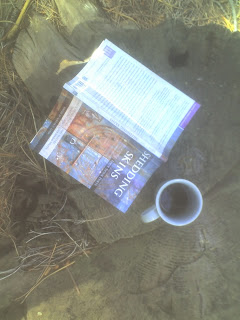
"To look at the river made of time and water
And remember that time is another river,
To know that we are lost like the river
And that faces dissolve like water."
This is a stanza from the poem "Ars Poetica." It was written by Argentina's visionary writer, Jorge Luis Borges, and translated from the Spanish by W.S. Merwin. I've been reading
Poems of the Night, a new selection of Borges's poems from Penguin Books (2010), and I took the book along with me to Lees Ferry last week.
My mother and my brother joined me there to celebrate my father's 75th birthday. It would have been impossible not to think about time when celebrating a milestone birthday, but add to that the presence of the millions-of-years-old rock the river's relentless current has exposed. And then the presence of the dam that brings us suddenly back to our own brief moment in geologic time.

During this trip, Borges's "Someone" became a favorite poem. I personally enjoyed the "mysterious happiness" he describes while on the river with my parents and my brother. Again, the translator is Merwin.
SOMEONE
A man worn down by time,
a man who does not even expect death
(the proofs of death are statistics
and everyone runs the risk
of being the first immortal),
a man who has learned to express thanks
for the day's alms:
sleep, routine, the taste of water,
an unsuspected etymology,
a Latin or Saxon verse,
the memory of a woman who left him
thirty years ago now
whom he can call to mind without bitterness,
a man who is aware that the present
is both future and oblivion,
a man who has betrayed
and has been betrayed,
may feel suddenly, when crossing the street,
a mysterious happiness
not coming from the side of hope
but but from an ancient innocence,
from his own root or from some diffused god.
He knows better than to look at it closely,
for there are reasons more terrible than tigers
which will prove to him
that wretchedness is his duty,
but he accepts humbly
this felicity, this glimmer.
Perhaps in death when the dust
is dust, we will be forever
this undecipherable root,
from which will grow forever,
serene or horrible,
our solitary heaven or hell.

And, yes, we caught lots of fish.
(Final Photo: Trent Pittard)


































